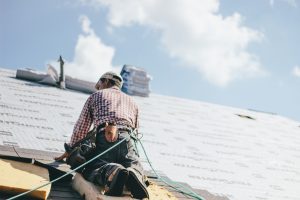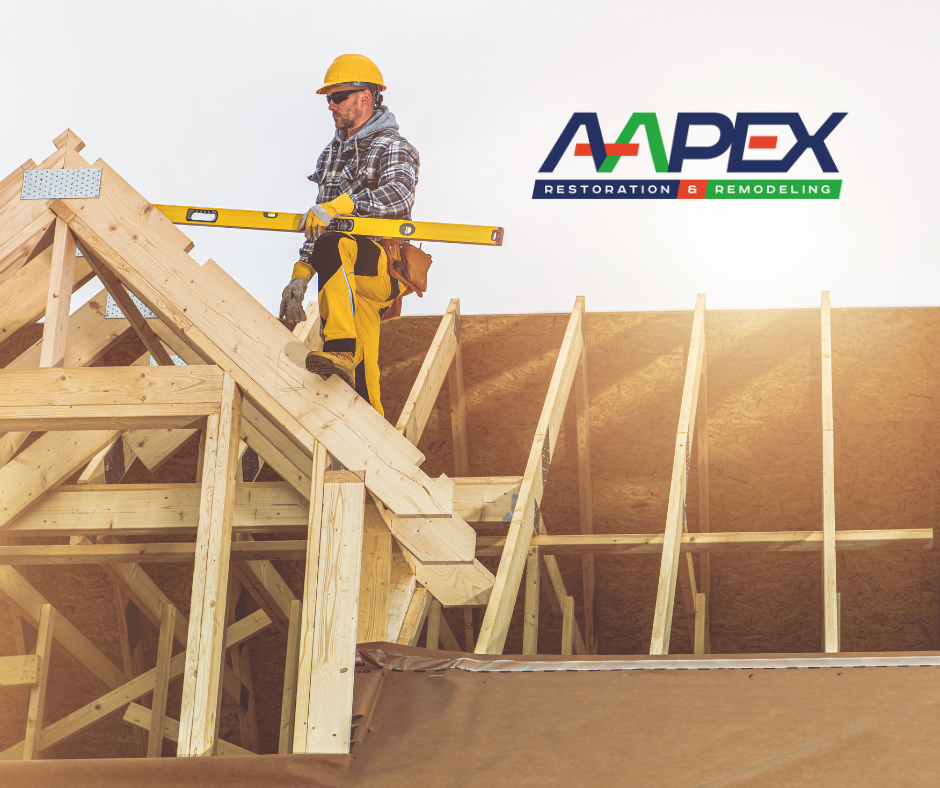When it comes to selecting materials for your building’s new roof, it may seem like you have an infinite number of choices at your disposal. Asphalt, metal, wood, clay, and even rubber. Many home and business owners mistakenly believe that the roofing material is purely aesthetic and that any option will work for any style roof. The truth is, however, your building’s roof pitch actually has a very significant impact on which choices will be feasible options. Read on to learn more about roof pitch and how it impacts your roofing material choices.
What is Roof Pitch & Why Does It Matter?
 Roof pitch is the measure of the steepness of your roof. As the most visible aspect of your roof, the pitch not only sets the aesthetic for your building, but it also serves a very important purpose. Roofs are designed to drain, diverting water to a building’s drainage system that works to direct water away from the foundation. Steeply pitched roofs do this by using gravity to direct water down toward the gutters. Flat or low-sloped roofs do this through a system of drains set up along the perimeter of the roof. The ultimate goal of a roof’s pitch (even for flat or low-sloped roofs) is to allow rain and snow to drain to prevent the pooling of water or snow accumulation.
Roof pitch is the measure of the steepness of your roof. As the most visible aspect of your roof, the pitch not only sets the aesthetic for your building, but it also serves a very important purpose. Roofs are designed to drain, diverting water to a building’s drainage system that works to direct water away from the foundation. Steeply pitched roofs do this by using gravity to direct water down toward the gutters. Flat or low-sloped roofs do this through a system of drains set up along the perimeter of the roof. The ultimate goal of a roof’s pitch (even for flat or low-sloped roofs) is to allow rain and snow to drain to prevent the pooling of water or snow accumulation.
Roof pitch is typically measured in inches and expressed as a ratio of the roof’s vertical rise to its horizontal run. For example, a roof with a pitch of 6:12 will rise six inches over a twelve-inch span. The larger the first number, the steeper the pitch.
Types of Roof Pitch
Generally speaking, there are four common types of roof pitch. Ranging from flat to steeply sloped. The type of pitch that’s most appropriate for a building will depend largely on the type of building it is as well as the climate where the building is located. Typically, higher pitches are used in regions that see more precipitation. In fact, in some areas where snow is much more common, including Ohio, building codes dictate minimum pitch requirements.
Flat Roof
Though the name implies otherwise, no roof is actually flat. Flat-pitched roofs have a slope of 1/4:12 to 1:12. Such a pitch may appear flat, but it actually provides enough of a slope to direct water to the drains on the perimeter of the roof. Flat-pitched roofs are most often used in commercial buildings.
Low-Slope Roof
Roofs ranging from 1:12 to 4:12 are considered to have a low-slope pitch. Easier to walk on, flat and low-slope roofs are more commonly used in commercial buildings or in regions, like the arid Southwest United States, that do not get a lot of rain throughout the year.
Medium-Slope Roof
Medium-slope roofs range in pitch from 4:12 to 9:12. The mid-range medium-slope roof has a pitch of 6:12 and is the most commonly used pitch for residential buildings. It offers great efficiency at diverting rain and snow water while also being relatively easy to walk on.
Steep-Slope Roof
Anything above a pitch of 9:12 is considered a steep slope. The most efficient at shedding water, steep-slope roofs tend to last longer than the rest and are most often seen in residential buildings. Materials used for steep-slope roofs tend to be more visually appealing because they are extremely visible from the ground, often accounting for more than 40% of the home’s exterior appearance.
Roofing Material & Pitch
 One primary purpose of a roof is to prevent water from pooling and seeping into the building below. Different roofing materials are designed to do this in different ways. For example, shingles – whether asphalt, wood, or slate – are similar to fish scales. They are designed to be layered, shedding water as it flows from the peak of the roof down to the gutters. They are not watertight when water is being directed upwards, which is why we have to be so diligent about preventing ice dams. As the roof’s pitch changes, so too do the available roofing materials.
One primary purpose of a roof is to prevent water from pooling and seeping into the building below. Different roofing materials are designed to do this in different ways. For example, shingles – whether asphalt, wood, or slate – are similar to fish scales. They are designed to be layered, shedding water as it flows from the peak of the roof down to the gutters. They are not watertight when water is being directed upwards, which is why we have to be so diligent about preventing ice dams. As the roof’s pitch changes, so too do the available roofing materials.
Built-Up, Torch-Down, & Rubber Membrane
Found in more urban houses and industrial buildings, roof pitches with lower angles require a material that will seal the surface from rain and snow while it more slowly makes its way to the drainage system. Flat roofing materials, for roof pitches between ¼:12 to 3/12, include built-up roofing (BUR), “torch-down” membrane roofing, and rubber membrane. Flat roofing materials work to create as watertight a seal as is possible, while still allowing the surface of the roof to expand and contract with changes in temperature.
Standing-Seam Metal Roof
Made from panels of steel or aluminum, standing-seam metal roofs are joined together in raised seams. They are perhaps the most versatile roofing material, when it comes to accommodating roof pitch. They can be used on roof pitches as low as ¼:12 all the way up to 19:12.
Clay or Cement Tile Roofing
Not as versatile as standing-seam metal, but still offering a pretty wide range, clay or cement tiles can be used for roof pitches between 2.5:12 all the way up to 19:12. For pitches shallower than 4:12, the roof may require a double underlayment to guard against the possibility of water intrusion. Anything higher than 19:12 may cause rattling during inclement weather.
Asphalt Shingles
Asphalt shingles account for more than 70% of the roofing materials used in US homes. Not only are they the most cost-effective choice, but they can accommodate roof pitches from 4:12 to 20:12 (and even higher). Traditional 3-tab shingles are the most popular choice.
Wood and Slate Shingles
Because they do not lock together as tightly as asphalt shingles, wood and slate shingles have a narrower range, accommodating roof pitches between 5:12 to 12:12. They are often used on residential buildings because of their durability (slate shingles can last as long as 100 years or more!), but they are not effective at guarding against water intrusion in shallower roofs. Similar to clay and cement tiles, they should not be used much higher than their upper range because they may start to shake and rattle during inclement weather.
Rely on Aapex Construction & Restoration for Your Roofing Needs!
Aapex Construction & Restoration is certified to work with all types of roofing structures and materials, regardless of roof pitch. We have more than 20 years of experience in the industry and are licensed, bonded, and insured to provide you with exceptional customer care. Contact us to discuss your roofing options today.
Related Articles
Built to Last: The Life Expectancy of 5 Popular Roofing Materials
Residential v. Commercial Roofs: The Main Differences
Design Tip: Choosing Your Home’s Roofing Color

